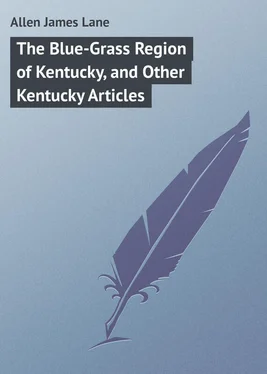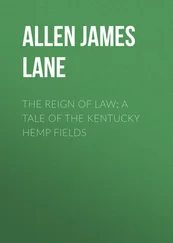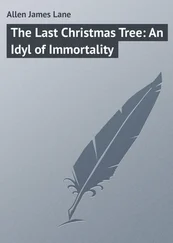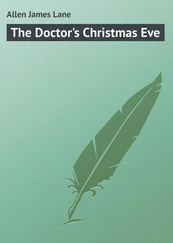James Allen - The Blue-Grass Region of Kentucky, and Other Kentucky Articles
Здесь есть возможность читать онлайн «James Allen - The Blue-Grass Region of Kentucky, and Other Kentucky Articles» — ознакомительный отрывок электронной книги совершенно бесплатно, а после прочтения отрывка купить полную версию. В некоторых случаях можно слушать аудио, скачать через торрент в формате fb2 и присутствует краткое содержание. Жанр: foreign_prose, Путешествия и география, на английском языке. Описание произведения, (предисловие) а так же отзывы посетителей доступны на портале библиотеки ЛибКат.
- Название:The Blue-Grass Region of Kentucky, and Other Kentucky Articles
- Автор:
- Жанр:
- Год:неизвестен
- ISBN:нет данных
- Рейтинг книги:3 / 5. Голосов: 1
-
Избранное:Добавить в избранное
- Отзывы:
-
Ваша оценка:
- 60
- 1
- 2
- 3
- 4
- 5
The Blue-Grass Region of Kentucky, and Other Kentucky Articles: краткое содержание, описание и аннотация
Предлагаем к чтению аннотацию, описание, краткое содержание или предисловие (зависит от того, что написал сам автор книги «The Blue-Grass Region of Kentucky, and Other Kentucky Articles»). Если вы не нашли необходимую информацию о книге — напишите в комментариях, мы постараемся отыскать её.
The Blue-Grass Region of Kentucky, and Other Kentucky Articles — читать онлайн ознакомительный отрывок
Ниже представлен текст книги, разбитый по страницам. Система сохранения места последней прочитанной страницы, позволяет с удобством читать онлайн бесплатно книгу «The Blue-Grass Region of Kentucky, and Other Kentucky Articles», без необходимости каждый раз заново искать на чём Вы остановились. Поставьте закладку, и сможете в любой момент перейти на страницу, на которой закончили чтение.
Интервал:
Закладка:
The women of Kentucky have long had reputation for beauty. An average type is a refinement on the English blonde – greater delicacy of form, feature, and color. A beautiful Kentucky woman is apt to be exceedingly beautiful. Her voice is low and soft; her hands and feet delicately formed; her skin pure and beautiful in tint and shading; her eyes blue or brown, and hair nut brown or golden brown; to all which is added a certain unapproachable refinement. It must not for a moment be supposed, however, that there are not many genuinely ugly women in Kentucky.
UNCLE TOM AT HOME
On the outskirts of the towns of central Kentucky, a stranger, searching for the picturesque in architecture and in life, would find his attention arrested by certain masses of low frame and brick structures, and by the multitudes of strange human beings that inhabit them. A single town may have on its edges several of these settlements, which are themselves called "towns," and bear separate names either descriptive of some topographical peculiarity or taken from the original owners of the lots. It is in these that a great part of the negro population of Kentucky has packed itself since the war. Here live the slaves of the past with their descendants; old family servants from the once populous country-places; old wagon-drivers from the deep-rutted lanes; old wood-choppers from the slaughtered blue-grass forests; old harvesters and ploughmen from the long since abandoned fields; old cooks from the savory, wasteful kitchens; old nurses from the softly rocked and softly sung-to cradles. Here, too, are the homes of the younger generation, of the laundresses and the barbers, teachers and ministers of the gospel, coachmen and porters, restaurant-keepers and vagabonds, hands from the hemp factories, and workmen on the outlying farms.
You step easily from the verge of the white population to the confines of the black. But it is a great distance – like the crossing of a vast continent between the habitats of alien races. The air seems all at once to tan the cheek. Out of the cold, blue recesses of the midsummer sky the sun burns with a fierceness of heat that warps the shingles of the pointed roofs and flares with blinding brilliancy against some whitewashed wall. Perhaps in all the street no little cooling stretch of shade. The unpaved sidewalks and the roadway between are but indistinguishable parts of a common thoroughfare, along which every upspringing green thing is quickly trodden to death beneath the ubiquitous play and passing of many feet. Here and there, from some shielded nook or other coign of vantage, a single plumy branch of dog-fennel may be seen spreading its small firmament of white and golden stars close to the ground; or between its pale green stalks the faint lavender of the nightshade will take the eye as the sole emblem of the flowering world.
A negro town! Looking out the doors and windows of the cabins, lounging in the door-ways, leaning over the low frame fences, gathering into quickly forming, quickly dissolving groups in the dusty streets, they swarm. They are here from milk-white through all deepening shades to glossy blackness; octoroons, quadroons, mulattoes – some with large liquid black eyes, refined features, delicate forms; working, gossiping, higgling over prices around a vegetable cart, discussing last night's church festival, to-day's funeral, or next week's railway excursion, sleeping, planning how to get work and how to escape it. From some unseen old figure in flamboyant turban, bending over the wash-tub in the rear of a cabin, comes a crooned song of indescribable pathos; behind a half-closed front shutter, a Moorish-hued amosoro in gay linen thrums his banjo in a measure of ecstatic gayety preluding the more passionate melodies of the coming night. Here a fight; there the sound of the fiddle and the rhythmic patting of hands. Tatters and silks flaunt themselves side by side. Dirt and cleanliness lie down together. Indolence goes hand in hand with thrift. Superstition dogs the slow footsteps of reason. Passion and self-control eye each other across the narrow way. If there is anywhere resolute virtue, round it is a weltered muck of low and sensual desire. One sees the surviving types of old negro life here crowded together with and contrasted with the new phases of "colored" life – sees the transitional stage of a race, part of whom were born slaves and are now freemen, part of whom have been born freemen but remain so much like slaves.
It cannot fail to happen, as you walk along, that you will come upon some cabin set back in a small yard and half hidden, front and side, by an almost tropical jungle of vines and multiform foliage: patches of great sunflowers, never more leonine in tawny magnificence and sun-loving repose; festoons of white and purple morning-glories over the windows and up to the low eaves; around the porch and above the door-way, a trellis of gourd-vines swinging their long-necked, grotesque yellow fruit; about the entrance flaming hollyhocks and other brilliant bits of bloom, marigolds and petunias – evidences of the warm, native taste that still distinguishes the negro after some centuries of contact with the cold, chastened ideals of the Anglo-Saxon.
In the door-way of such a cabin, sheltered from the afternoon sun by his dense jungle of vines, but with a few rays of light glinting through the fluttering leaves across his seamed black face and white woolly head, the muscles of his once powerful arms shrunken, the gnarled hands folded idly in his lap – his occupation gone – you will haply see some old-time slave of the class of Mrs. Stowe's Uncle Tom. For it is true that scattered here and there throughout the negro towns of Kentucky are representatives of the same class that furnished her with her hero; true, also, that they were never sold by their Kentucky masters to the plantations of the South, but remained unsold down to the last days of slavery.
When the war scattered the negroes of Kentucky blindly, tumultuously, hither and thither, many of them gathered the members of their families about them and moved from the country into these "towns;" and here the few survivors live, ready to testify of their relations with their former masters and mistresses, and indirectly serving to point a great moral: that, however justly Mrs. Stowe may have chosen one of their number as best fitted to show the fairest aspects of domestic slavery in the United States, she departed from the common truth of history, as it respected their lot in life, when she condemned her Uncle Tom to his tragical fate. For it was not the character of Uncle Tom that she greatly idealized, as has been so often asserted; it was the category of events that were made to befall him.
As citizens of the American Republic, these old negroes – now known as "colored gentlemen," surrounded by "colored ladies and gentlemen" – have not done a great deal. The bud of liberty was ingrafted too late on the ancient slave-stock to bear much fruit. But they are interesting, as contemporaries of a type of Kentucky negro whose virtues and whose sorrows, dramatically embodied in literature, have become a by-word throughout the civilized world. And now that the war-cloud is lifting from over the landscape of the past, so that it lies still clear to the eyes of those who were once the dwellers amid its scenes, it is perhaps a good time to scan it and note some of its great moral landmarks before it grows remoter and is finally forgotten.
These three types – Mrs. Stowe's Uncle Tom, and the Shelbys, his master and mistress – were the outgrowth of natural and historic conditions peculiar to Kentucky. "Perhaps," wrote Mrs. Stowe in her novel, "the mildest form of the system of slavery is to be seen in the State of Kentucky. The general prevalence of agricultural pursuits of a quiet and gradual nature, not requiring those periodic seasons of hurry and pressure that are called for in the business of more southern districts, makes the task of the negro a more healthful and reasonable one; while the master, content with a more gradual style of acquisition, had not those temptations to hard-heartedness which always overcome frail human nature, when the prospect of sudden and rapid gain is weighed in the balance with no heavier counterpoise than the interests of the helpless and unprotected." These words contain many truths.
Читать дальшеИнтервал:
Закладка:
Похожие книги на «The Blue-Grass Region of Kentucky, and Other Kentucky Articles»
Представляем Вашему вниманию похожие книги на «The Blue-Grass Region of Kentucky, and Other Kentucky Articles» списком для выбора. Мы отобрали схожую по названию и смыслу литературу в надежде предоставить читателям больше вариантов отыскать новые, интересные, ещё непрочитанные произведения.
Обсуждение, отзывы о книге «The Blue-Grass Region of Kentucky, and Other Kentucky Articles» и просто собственные мнения читателей. Оставьте ваши комментарии, напишите, что Вы думаете о произведении, его смысле или главных героях. Укажите что конкретно понравилось, а что нет, и почему Вы так считаете.











